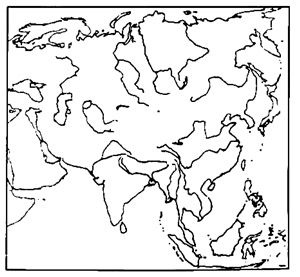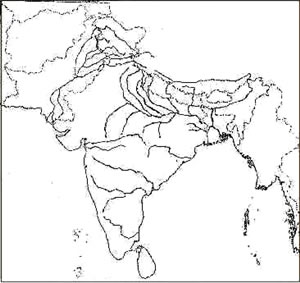(Geography) ICSE Class X Important Questions : Geography (2003)
Disclaimer: This website is NOT associated with CBSE, for official website of CBSE visit - www.cbse.gov.in
Paper : ICSE Class X Important Questions : Geography (2003)
General Instructions
- Section A is compulsory. All questions from Section A are to be attempted.
- Answer any two questions from Section B andanswer any three questionsfrom Section C.
- The intended marks for questions or parts of questions are given in brackets [ ].
SECTION - A
Attempt all questions from this Section.
Question 1
Study the extract of the Survey of India Map Sheet No. 45 D/10 and answer the
following questions:
Click here for Survey of India Map Sheet No. 45 D/10.
(a) Give the four figure grid reference of:
- Dadarla
- Bhamra.[2]
(b) Which is the largest settlement shown on the map extract? Which one communication facility is exclusively available to this settlement? [2]
(c) What does RF stand for? State the RF of the map provided to you. [2]
(d) What is the total area of the actual ground represented in the map extract? (Show with the help of a simple calculation).[2]
(e) What is meant by 'contour interval'? State the contour interval of the toposheet provided to you. [2]
(f) State the highest and the lowest spot heights found on the map extract. Also mention whether they are in metres or in feets. [2]
(g) Give the six figure grid reference of:
- Spot height 339
- Permanent hut located near Dhad Talao.[2]
(h) What, according to you is the main (i) occupation and (ii) religion of the people of the above area? [2]
(i) Name one 'natural' and one 'man-made' source of irrigation used in this region. [2]
(j) Name the general mode of transportation used in this region. What special feature of this mode is mentioned in the map extract? [2]
SECTION - B
Answer any two question from this Section.
Question 2
On the outline map of Asia provided:

(a) Mark and label the river Ob. [1]
(b) Shade and label the Plateau of Iran. [1]
(c) Mark with a bold line and label the Zagros mountains. [1]
(d) Shade and label the Caspian Sea. [1]
(e) Mark with a bold line and label the Tian Shan mountains. [1]
(f) Shade and label the country known as the Land of the Rising Sun. [1]
(g) Shade and label South Korea. [1]
(h) Shade and name the Tarim Basin.. [1]
(i) Shade and print 'coniferous' over one region where these forests cover an extensive area. [1]
(j) Shade and name the South China Sea. [1]
(k) Mark the 66.5 latitude (The Arctic Circle). [1]
(l)Shade and label the Shan Plateau. [1]
Question 3
On the outline map of the Indian sub-continent provided:

(a) Mark with a bold line and label: [3]
- The Karakorarn Range.
- The Eastern Ghats.
- The Nilgiris.
(b) Shade and name one region for each of the following: [3]
- Desert vegetation.
- Black soil.
- Tobacco Cultivation.
(c) Mark and label: [3]
- The Khyber Pass.
- The capital city of Assam.
- River Godavari.
(d) [3]
- Identify shade and name:
1. A region of sparse population (less than 50 person per sq. km.) in North Eastern India.
2. A region of 'Equatorial Forests.' - Mark with one long arrow, the direction of the Summer Monsoon over the Bay of Bengal.
Question 4
(a) State the latitudinal and longitudinal extent of India. Which important line of latitude passes through the middle of India? [2]
(b) (i) Differentiate between Afforestation and Deforestation.
(ii) Where is xerophytic vegetation found? Give two ways in which it is adapted to the climatic conditions of that area. [2]
(c) Define 'Leaching'. In which region, south of the Tropic of Cancer, can one firm soil formed by 'Leaching'? [2]
(d) What are Western disturbances? How do they affect the climate of India? [2]
(e) Study the climatic data given below and answer the questions that follow:
| Station | Months | J | F | M | A | M | J | J | A | S | O | N | D |
| A | Temp. in Degree C | 14.4 | 16.7 | 23.3 | 30.0 | 33.3 | 33.3 | 30.0 | 29.4 | 28.9 | 25.6 | 19.4 | 15.6 |
| Rainfall in cms. | 2.5 | 1.5 | 1.3 | 1.0 | 1.8 | 7.4 | 19.3 | 17.8 | 11.9 | 1.3 | 0.2 | 1.0 | |
| B | Temp. in Degree C | 24.4 | 24.4 | 26.7 | 28.3 | 30.0 | 28.9 | 27.2 | 27.2 | 27.2 | 27.8 | 27.2 | 25.0 |
| Rainfall in cms. | 0.2 | 0.2 | - | - | 1.8 | 50.6 | 61.0 | 36.9 | 24.8 | 4.8 | 1.0 | - |
- Calculate the annual rainfall for station A. [1]
- What is the annual range of temperature at station B? [1]
- In which hemisphere do you think station A lies? [1]
- Which of these stations has an equable climate? [1]
SECTION - C
Answer any three questions from this Section.
Question 5
(a) State two differences between intensive and extensive agriculture. [2]
(b) Name an area of wheat cultivation in India and state why it is suitable for the cultivation of wheat. (Mention two reasons). [2]
(c) Do you think that the cultivation of pulses is lagging behind in recent times? Give two reasons to justify your view. [2]
(d) Mention two problems faced by the sugarcane cultivators in India and state the role of the Central Government in solving these problems. [2]
(e) In the context of the Indian agriculture, answer the following:
- Mention two features which reflect a shift from subsistence farming to commercial farming. [1]
- Give two reasons, why the yield of Indian agriculture is low as compared - to world standards?[1]
- State two characteristics of plantation agriculture. [1]
- How has the consolidation of land holdings helped the farming community? [1]
Question 6
(a) With the help of an example each, explain, how 'agro-based' industries are different from 'mineral based' industries? [2]
(b) State two reasons to justify the momentum gained by the cement industry in recent times. [2]
(c) Give four reasons to justify that the rayon textile industry in India has a great future. [2]
(d) State one reason each to explain the importance of the chemical industry with regard to (i) Agriculture and (ii ) Public health. [2]
(e) With reference to the iron and steel industry in India, give logical explanations for the followings:
- The location of this industry is governed by its close proximity to raw material. [1]
- This industry is not found in Western India. [1]
- Most of the 'iron and steel' plants are 'Public Sector Undertakings'. [1]
- Mini steel plants are becoming more popular. [1]
Question 7
(a) (i) Which state of India is the leading producer of 'groundnut'? (ii) Give three uses of groundnuts [2]
(b) Why is the woolen textile industry not as well developed as the cotton textile industry in India? [2]
(c) Name the seed obtained from the flax plant. Name two commercial uses of its oil and one use of its oil-cake. [2]
(d) State two reasons to explain, why the cultivation of oils seeds is lagging behind in recent times? [2]
(e)
- In which part of India is the rubber plant grown on a commercial scale? [1]
- Name any two coal based thermal power stations in India. [1]
- Name two regions in India where cinchona is grown. [1]
- Why is cinchona considered an important medicinal plant? [1]
Question 8
(a) Which multi-purpose power project has been built on the river Sutlej? Name the States that are benefited by this project. [2]
(b) Name two states which are being served by the Tungabhadra Project. What are the main features of this project. [2]
(c) How are tube-wells beneficial to farmers in North-India? [2]
(d) State four disadvantages of tank irrigation in South India? [2]
(e)
- 'Multi-Purpose Projects' are vital to the development of India. Explain. [1]
- Name any two coal based thermal power stations in India. [1]
- Mention two differences between a dam and a barrage. [1]
- State two hazards of constructing dam. [1]
Question 9
(a) How is nuclear power obtained? In which State is 'Kalpakkam Nuclear Power Project located. [2]
(b) State the main requirements for obtaining energy from the force of wind. [2]
(c) State two rnain issues related to the 'Narmada Valley Project' controversy. [2]
(d) Name the rnain source of solar energy. Mention two practical uses of solar energy. [2]
(e)
- What is Bio-gas? [1]
- Why is it a popular source of energy in rural areas? [1]
- State the disadvantages of setting up a Bio-gas plant. [1]
- How is the Government helping in the setting-up of Bio-gas plants? [1]